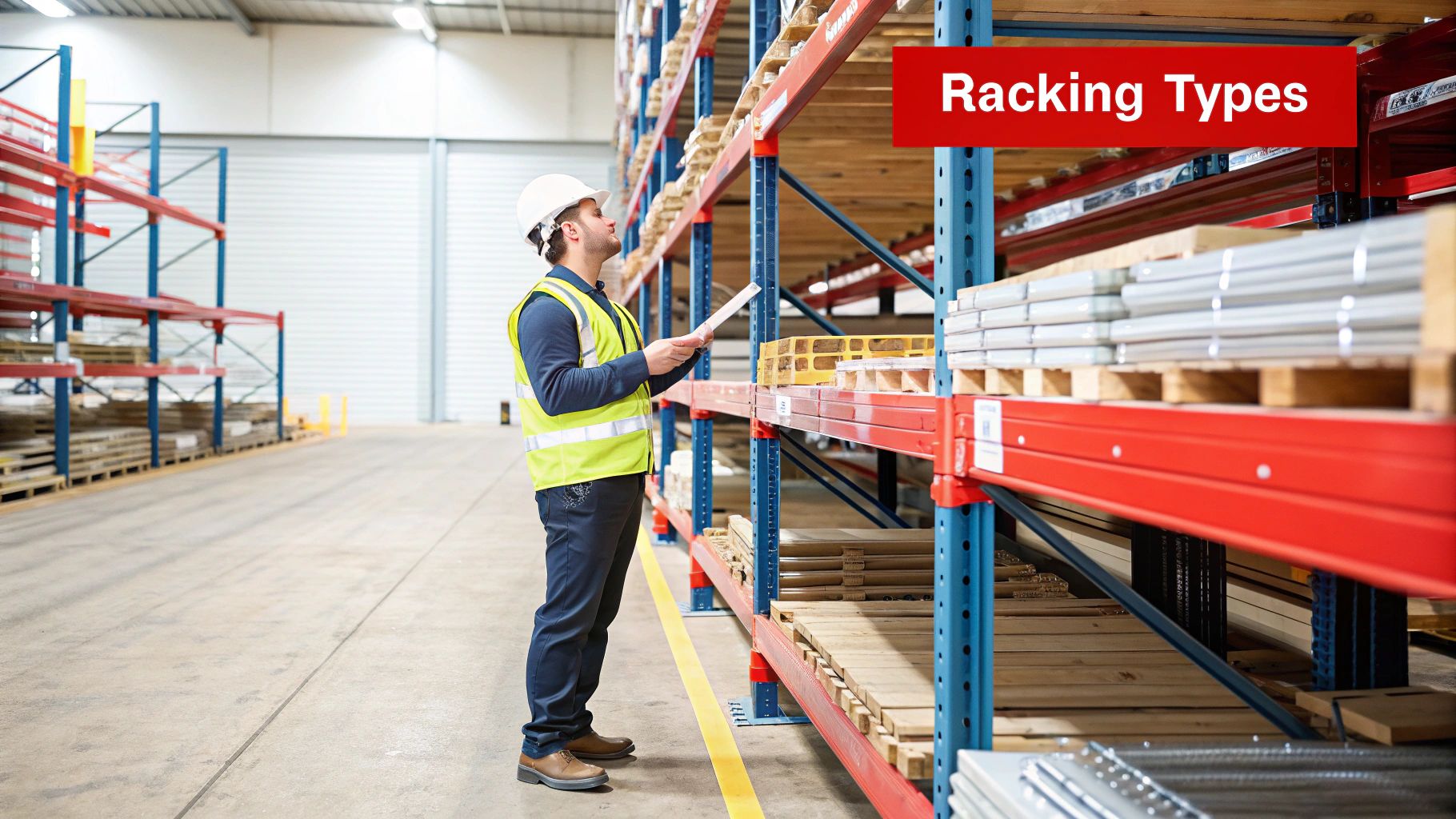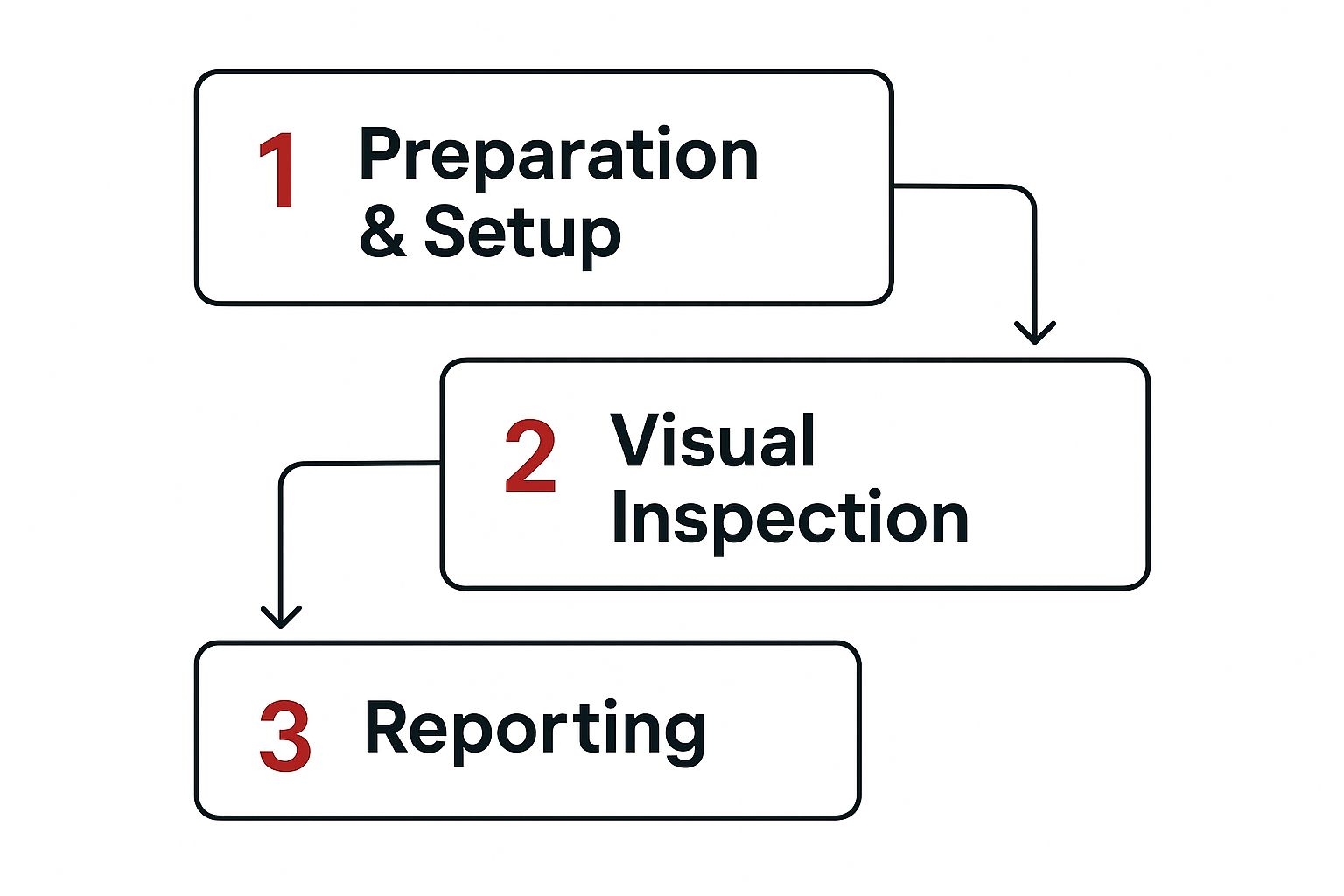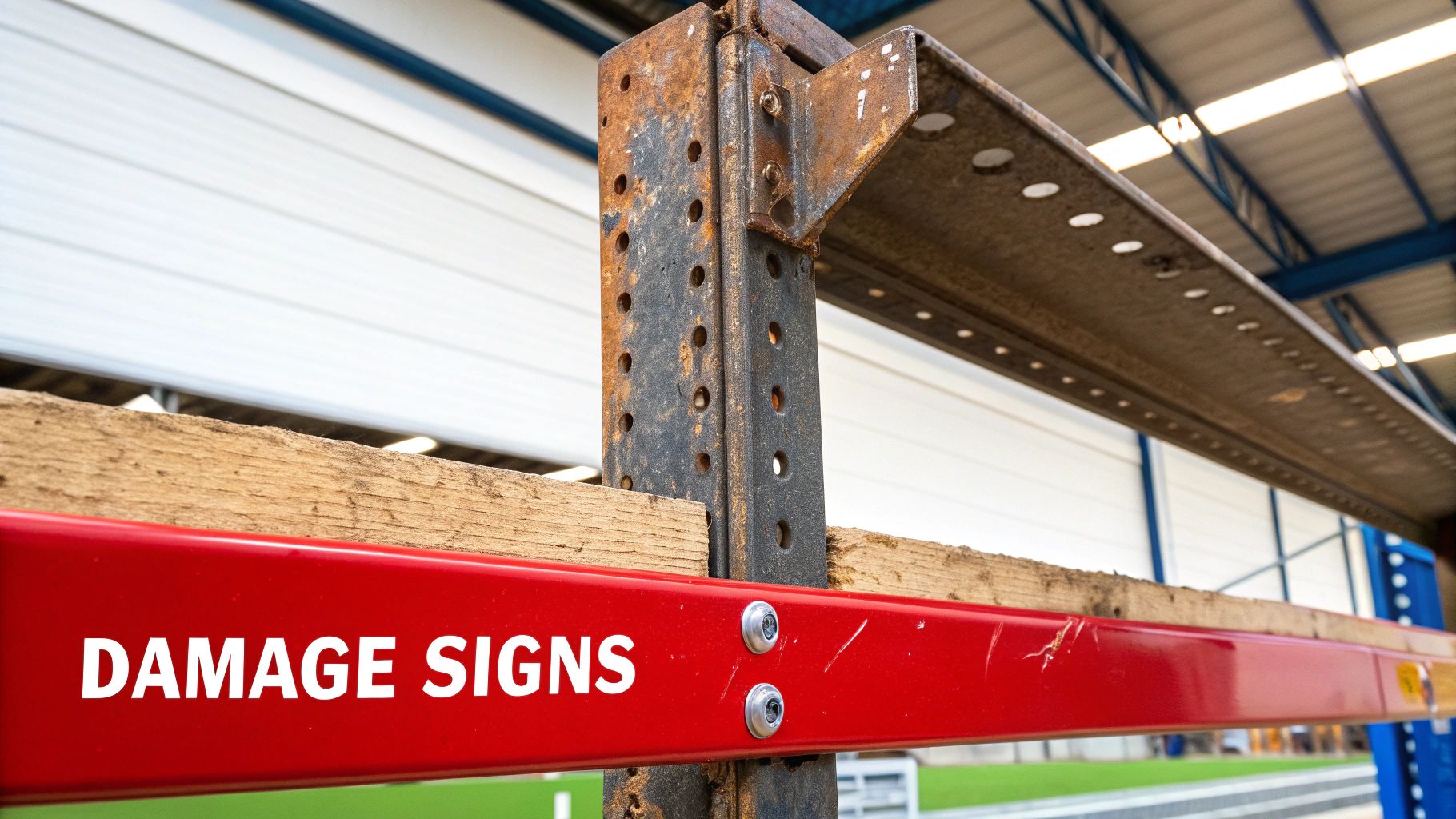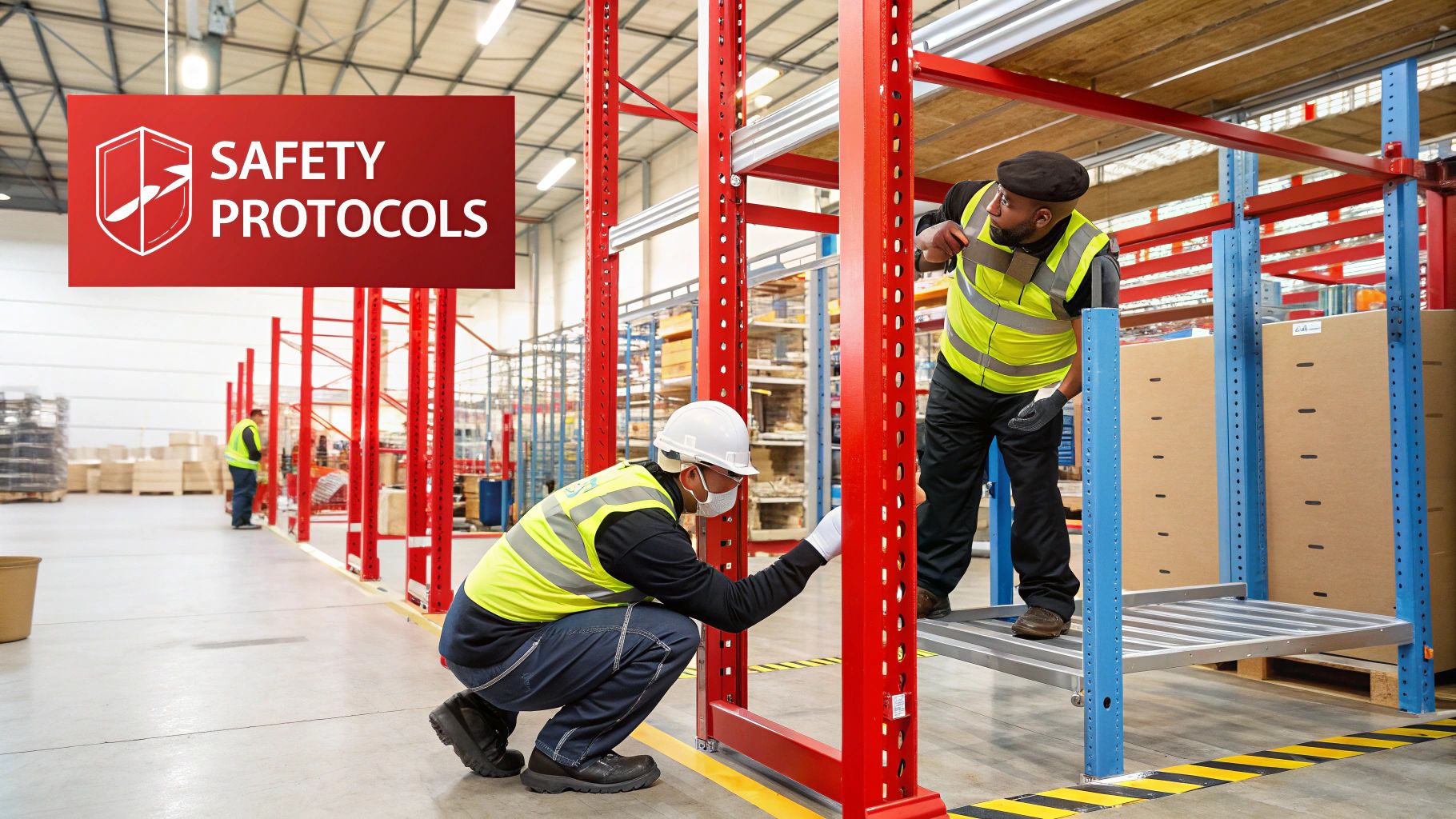Think of a warehouse racking inspection as more than just a routine check-up. It's a critical safety procedure, the bedrock of ensuring your storage systems are structurally sound. It involves a methodical review of every component—from the uprights and beams right down to the anchors—to spot any damage from daily operations before it can lead to a dangerous collapse. This isn't just about compliance; it's about protecting your staff, your stock, and your business.
Your warehouse is a dynamic environment. Forklifts are always on the move, pallets are constantly being loaded and unloaded, and all this activity puts enormous, often unseen, stress on your racking. Over time, what might seem like minor bumps and scrapes can accumulate, slowly turning small issues into major structural weaknesses.
A regular warehouse racking inspection is a fundamental part of workplace health and safety, not just another box to tick on a form.
If this crucial task is neglected, the consequences can be catastrophic. The absolute worst-case scenario is a full rack collapse. This can cause severe injuries or fatalities, destroy tens of thousands of dollars in stock, and bring your entire operation to a grinding halt for weeks. The ripple effects of a disaster like that can cripple a business, hitting everything from your bottom line to your hard-earned reputation.
Here in Australia, warehouse safety isn't something left to chance. The whole process is governed by specific regulations to make sure there's a consistent standard of care in every facility.
The gold standard for pallet racking safety is Australian Standard AS 4084. This standard lays out clear guidelines on the design, installation, and, critically, the ongoing inspection of steel storage racking. It's a practical framework built on decades of engineering experience, all designed to prevent disasters by setting minimum requirements for keeping your racking safe and operational.
Your first and best line of defence against racking failure is simple: invest in quality from day one. While inspections are vital for ongoing maintenance, the initial durability and engineering of your system play a huge part in its long-term safety.
Investing in high-quality, certified racking is not an expense; it's an investment in the safety of your people, the security of your stock, and the continuity of your business. A well-built system can withstand the rigours of a busy warehouse far better than a cheaper, lower-grade alternative.
Choosing a trusted supplier like Super Rack means you get a system engineered for durability and compliance right out of the box. Our racking is built to meet and exceed Australian Standards, giving you peace of mind from the moment it's installed. When you combine that with our competitive pricing and expert advice, you get a solution that puts safety first without blowing the budget. Take a look at our range of robust pallet storage racking to see how a strong foundation makes safety management that much easier.
Failing to maintain your racking isn't just a safety risk—it's a massive legal and financial one. Under Australian Standard AS 4084, professional inspections of steel storage racking are mandatory at least once every 12 months. This frequency needs to increase in high-traffic warehouses where the risk of damage is higher.
Ignoring these rules can lead to serious penalties, including hefty fines or even charges of industrial manslaughter if an accident is traced back to neglected maintenance. On top of that, non-compliance can void your insurance policies, leaving you to foot the entire bill for any incidents.
Ultimately, a diligent inspection routine protects your most valuable assets: your people and your business. With Super Rack’s fast, nationwide delivery, you can get the high-quality components you need to maintain a safe and efficient warehouse without delay.
Keeping your warehouse safe isn't just good business sense—it's a legal requirement. While navigating the rules can feel like a headache, it all boils down to proactive care and taking your responsibilities seriously. In Australia, the go-to document for warehouse safety is AS 4084, the national standard for steel storage racking.
This standard is more than just a list of suggestions. It's the official benchmark that SafeWork inspectors use to judge whether you’re meeting your duty of care. Getting your head around these obligations is the first real step towards running a compliant, secure, and genuinely safe operation.

Here's the most critical point in AS 4084: the mandatory annual inspection. At a minimum, your entire racking system needs a professional inspection by a competent person at least once every 12 months.
Let's be clear—this isn't a job for your in-house maintenance crew. This inspection must be done by a qualified, independent expert who genuinely understands the engineering and common failure points of industrial pallet racking. Their job is to give you an unbiased, expert assessment of your system's health, checking everything from structural damage to load sign accuracy.
The standard uses the term "competent person" very deliberately. It refers to someone with the specific training, qualifications, and real-world experience needed to spot hazards and structural weaknesses in pallet racking. These are typically engineers or specialised inspectors who have no skin in the game—they're independent of both the racking supplier and your business.
Using a third-party expert guarantees the assessment is objective. They’re not there to sell you anything; they’re there to provide a clear, factual report on your racking’s condition and tell you exactly what needs fixing to stay safe and compliant.
Compliance lives and dies by your documentation. If a SafeWork inspector ever pays you a visit, the first thing they'll ask for is your records. Just telling them you’ve done an inspection won’t cut it. You have to prove it.
Think of it as the service logbook for your racking. Your file should contain:
This paper trail demonstrates a consistent, ongoing commitment to safety and makes any audit a straightforward process.
Imagine you get that email: a SafeWork inspector is visiting next week. For some, it’s panic stations. But for you, it’s just another Tuesday.
Instead of a last-minute scramble, you can calmly pull out your racking logbook. It clearly shows the date of your last professional inspection (well within the 12-month window), the report that flagged two damaged uprights, and a follow-up entry confirming the repairs were completed with certified parts two weeks later. That level of organisation tells an inspector everything they need to know about your safety culture.
The consequences of dropping the ball on compliance are huge. Ignoring your inspection duties can lead to crippling fines—potentially hundreds of thousands of dollars for a business if an accident happens. In the worst-case scenarios, company directors can even face personal prosecution.
Beyond the legal threats, the financial fallout can be devastating. An insurance company could refuse a claim for a racking collapse if you can't prove you followed Australian Standards. The cost of replacing stock and equipment, plus the operational downtime, could put a serious dent in any business.
Starting with a high-quality system makes this whole process so much simpler. Super Rack's racking is engineered to meet and exceed AS 4084 from day one, giving you a compliant foundation. From there, our team can provide the advice you need to maintain it for the long haul. It's a smart investment—fewer repairs, easier compliance, and a safer warehouse for everyone.
Your mandatory annual warehouse racking inspection is critical, but what about the other eleven months of the year? Damage doesn't wait for a scheduled appointment. That's where regular, informal checks by your own team come in. They are one of the most powerful ways to spot trouble early, long before a minor issue escalates into a major safety hazard.
Think of it like checking the tyres on a company vehicle—you wouldn't wait for the annual service to notice one is flat. This proactive mindset empowers your staff, giving them the ownership to identify risks and maintain a safer workplace day in and day out.
This simple workflow breaks down the core stages of an effective internal check.

As the infographic shows, a proper check is more than a quick glance. It’s a structured process, from preparing your team to documenting and reporting what you find.
The stability of your entire racking system literally starts at the floor. It's a high-impact area and the first place you should look, because a solid foundation is completely non-negotiable for structural integrity.
Get down low and examine the base plates and anchors for each upright.
The uprights (or frames) are the vertical pillars that carry the entire weight of your inventory. They also happen to be the component most frequently hit by forklifts, so any damage here can be incredibly serious.
Look closely for any sign of twisting, bending, or buckling. Even a subtle twist can dramatically reduce an upright's load-bearing capacity. A good trick is to run your hand along the front and side faces—you can often feel slight deformations that are hard to spot with your eyes alone. Any dent, cut, or significant scrape needs to be documented immediately.
Next, look up at the horizontal beams. These are what your pallets sit on, so their condition is just as vital.
Scan for any deflection, which is a fancy word for sagging in the middle of a beam. A visibly bowed beam is a clear sign it's been overloaded. At the same time, check the beam connectors where they lock into the uprights. Make sure they are fully engaged and that the safety clips or locking pins are correctly installed. These little clips are absolutely essential—they stop a forklift from accidentally lifting a beam clean out of its housing.
Data from Australian workplace safety authorities shows that pallet racking is a major focus area due to risks from overloading and physical damage. SafeWork NSW guidelines zero in on common problems like beam deformation (a classic sign of overloading) and missing safety clips, which dramatically increase collapse risk. Some Aussie audits have linked over 30% of racking failures directly to minor damage that was overlooked. This is precisely why these internal checks are so important.
An inspection is only as good as its records. A simple logbook or checklist for your team is all you need. For every issue they spot, they should record:
Snapping a quick photo with a phone is also a brilliant way to log the issue. This creates a clear paper trail for getting repairs done and helps you identify recurring problem areas in your warehouse. To properly classify damage and perform safety checks, understanding diverse risk assessment methods is a huge help.
While these internal checks are a powerful tool, they don't replace a professional audit. If you find any significant damage or you're just not sure about the safety of a component, it’s always best to call in an expert. The team at Super Rack can help you understand your obligations and provide practical guidance on keeping your system safe and compliant. Find out more about arranging a professional pallet racking audit to ensure your warehouse meets the highest safety standards.
Once you start looking, you'll quickly realise that not all racking damage is the same. A minor scuff from a passing pallet is worlds apart from a deep dent caused by a direct forklift impact. Learning how to properly identify and classify what you find during a warehouse racking inspection is the key to taking the right action.
This process removes the guesswork. It gives you a clear, simple framework for deciding what needs immediate attention and what can be safely monitored, ensuring you focus your resources where they’re needed most.

To keep things straightforward, the storage industry uses a simple ‘traffic light’ system. It’s a practical approach that your entire team can easily understand and apply during their internal checks. This method sorts damage into three distinct levels of severity, each with a clear, predefined action plan.
Here’s how it breaks down:
Green (Monitor): This is for minor, superficial stuff. Think light scratches, small scrapes, or very slight surface dents that don't affect the component's shape or strength. The structural integrity isn't compromised, but it’s smart to note it in your logbook to keep an eye on.
Amber (Unload and Assess): Now we're talking about more serious damage that needs action. This could be a noticeable dent in an upright, a slightly twisted brace, or a beam showing minor deflection. The rule here is non-negotiable: unload the affected bay immediately and get a qualified person to assess it. It might be repairable, but it’s not safe to use until it’s been professionally cleared.
Red (Quarantine Immediately): This is the highest alert for critical damage that poses an immediate risk of collapse. We’re talking about a badly buckled upright, a sheared anchor bolt, a deeply bowed beam, or any visible cracks in the welds. The area must be cordoned off and quarantined straight away. Nobody should enter the area until a professional inspector has assessed it and the component has been replaced.
Using this system consistently turns a vague observation like "there's a dent in the racking" into a specific, actionable instruction like "that's an Amber-level dent, we need to unload that bay now." This clarity is vital for maintaining a safe warehouse.
Understanding why damage happens is the first step toward stopping it. While accidents are a part of warehouse life, many common issues can be minimised with a bit of foresight.
Forklift impacts are, by a long shot, the most frequent cause of serious racking damage. These often occur on the lower sections of uprights, which are right in the firing line. Another big one is overloading—when beams are loaded beyond their specified weight capacity, causing them to sag and weaken over time.
WorkSafe Victoria reminds us that while formal inspections must happen every 12 months, the daily grind means damage can occur at any time. Their findings often highlight forklift damage as a leading issue, while some studies show that up to 25% of racking incidents are linked to incorrect pallet loading, not a fault with the racking itself.
One of the most effective ways to prevent common damage is to shield your most vulnerable components. Installing robust, high-visibility protectors around the base of your racking uprights is a simple yet incredibly effective strategy.
These protectors act as a buffer, absorbing the force from accidental bumps and knocks from forklifts and other equipment. They are a cost-effective way to significantly reduce repair costs and downtime.
At Super Rack, we offer a range of heavy-duty Super Rack's Pallet Racking Protectors designed to safeguard your investment. With our competitive pricing and fast, nationwide delivery, protecting your racking is a simple and affordable step toward a safer warehouse.
A warehouse racking inspection is only the first step. Let's be honest, a report gathering dust in a folder doesn't make your warehouse any safer. The real value comes from what you do next: turning those findings into a clear-cut action plan that protects your team, your stock, and your business.
Prompt, organised follow-up is what transforms a simple compliance check into a genuine safety improvement. It’s about drawing a straight line from identifying a problem to fixing it, ensuring nothing gets missed.

The first job is to sort through your report and prioritise. This is exactly what the traffic light system is for—it instantly tells you where to focus your attention.
When you find Amber or Red level damage, safely unloading and isolating the area is critical. Don't just stick up a single sign and hope for the best. Use high-visibility barriers, cones, or safety tape to create an obvious exclusion zone around the entire bay, from the floor right up to the top beam.
Make sure you communicate clearly with your whole team, especially forklift operators, about which areas are off-limits and why. This is crucial for preventing any accidental use of compromised racking, which could have disastrous consequences. A visible, well-managed quarantine process is a non-negotiable part of warehouse safety.
Taking decisive action is the most important part of the entire inspection process. A detailed report of hazards is useless without a structured plan to eliminate them. Prompt repairs turn findings into tangible safety improvements.
Once the damage is prioritised and the areas are secured, it's time to map out your repairs. This is where having a reliable supplier makes all the difference. Downtime costs money, and waiting weeks for a replacement component simply isn't an option for a busy warehouse.
This is a key reason why so many businesses partner with Super Rack. We pride ourselves on fast, nationwide delivery, ensuring you get the high-quality, compliant replacement parts you need without delay. Our expert team can also offer practical advice on the best course of action, helping you make smart decisions about repairing versus replacing.
Your action plan should clearly document:
Keeping these detailed records is essential for your compliance logbook. It demonstrates a proactive approach to safety and proves you took immediate steps to fix known hazards—which is exactly what a SafeWork inspector wants to see. This approach turns your warehouse racking inspection into a complete, documented safety cycle.
Even with a solid plan, it’s normal to have a few questions about the nitty-gritty of a warehouse racking inspection. Getting clear, straight answers is the best way to ensure your process isn’t just about ticking boxes, but genuinely keeping your team safe.
Here are some of the most common queries we get from warehouse managers across Australia.
Australian Standard AS 4084 is black and white on this: you need a professional inspection at least once every 12 months. That’s the absolute minimum to stay compliant.
But let’s be realistic. If your warehouse is a high-traffic zone with forklifts constantly on the move and heavy loads being shifted, waiting a full year is a risky game. For busy operations, you should be doing your own informal checks far more often. A quick walkthrough every month or even weekly to spot obvious damage is a smart, proactive move.
In short, no. The official annual inspection must be carried out by a 'competent person'. The standard is very specific here—it means an independent expert with the right training, experience, and qualifications to assess your racking against Australian Standards.
Your team is absolutely essential for those regular internal checks, but the formal annual inspection needs a fresh, impartial set of eyes. This guarantees an unbiased assessment that meets legal requirements and removes any potential conflict of interest.
Hands down, the most common issue we see is forklift damage to the front of uprights, especially within the first two metres off the ground. That zone is constantly in the line of fire during loading and unloading.
You also need to keep an eye out for beams that are bent or sagging in the middle—a classic sign of overloading. Another critical problem that’s surprisingly easy to miss is missing safety clips on beam connectors. These little pins are vital. Without them, a beam could be accidentally lifted and dislodged by a forklift, with disastrous consequences.
A dedicated racking logbook is non-negotiable. Think of it as the service history for your entire storage system. If a SafeWork inspector walks in, this is the first thing they’ll ask to see.
Your logbook needs to have everything in one place:
Keeping this file up to date proves you’re serious about safety and makes any audit a smooth, straightforward process.
At Super Rack, we know that a safe warehouse is an efficient one. Our expert team is ready to offer practical advice, and with fast, nationwide delivery, you can get the high-quality, compliant racking components you need to uphold the highest safety standards.
Explore our full range of superior storage solutions at Super Rack
4000 to 4182
4186 to 4207
4300 to 4305
3000 To 3096
3098 To 3112
3114 To 3138
3140 To 3157
3161 To 3198
3200 To 3207
Let's connect